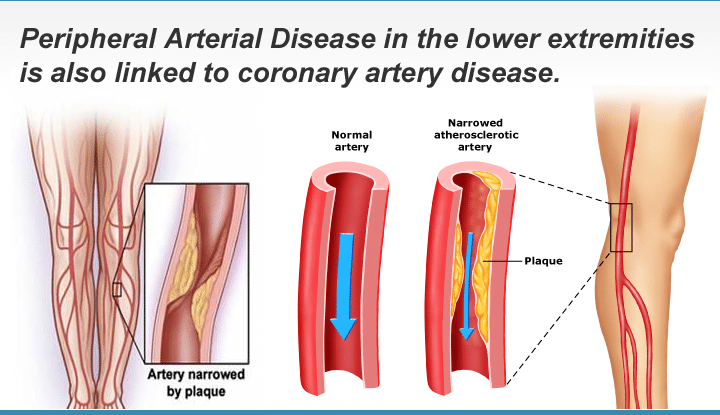Who Can Get Peripheral Arterial Disease (PAD)?
It is estimated that 1 out of every 20 Americans over the age of 50 has Peripheral Arterial Disease (PAD). However, the presence of certain diseases and conditions may cause the development of PAD earlier in life. These conditions include smoking, diabetes, high blood pressure and high cholesterol levels. African-Americans are more than twice as likely to develop PAD compared to Caucasians.

What Are the Symptoms of Peripheral Arterial Disease?
- Loss of hair on legs
- Color change in skin of legs or feet
- Aching in feet or toes when resting
- Cold legs or feet
- Sores on legs or feet that won’t heal
- Leg or hip pain that stops when you cease activity

What Puts Me at Risk?
- The main risk factor for Peripheral Arterial Disease (PAD) is smoking or a history of smoking. You can slow the progress of PAD if you quit smoking now.
- People of older age are at a higher risk of developing PAD because plaque builds up in the arteries over time.
- Some diseases and medical conditions, such as Diabetes, High Blood Pressure, High Cholesterol, Heart Disease, and Stroke, may raise your risk of developing PAD.
How Is Peripheral Arterial Disease (PAD) Diagnosed?
Peripheral Arterial Disease is diagnosed using ultrasound imaging, as well as through a patient’s medical history. Less commonly, other methods of diagnosis may be necessary.
How Is Peripheral Arterial Disease (PAD) Treated?
First line treatments offered by primary care doctors and vascular specialists include stopping smoking, exercise and eating healthy. Just by following a healthy lifestyle, the progression of peripheral arterial disease can be slowed, halted, or even reversed. Exercising conditions the body to overcome the lack of blood flow to the muscles and also increases flow through smaller arteries around the narrowed or blocked segments. Medications that lower blood pressure and cholesterol are one of the first steps in managing PAD. Unfortunately for many patients, medication and lifestyle changes aren’t enough, and minimally invasive treatment may be needed. In those cases, Precision VIR physicians offer these procedures to directly increase the flow through the blocked or narrowed part of the artery:
- Angioplasty
- Atherectomy
- Stenting
These treatments are, safe, state-of-the-art, minimally invasive procedures performed by our expert PAD doctors at Precision VIR in Dallas, Texas.
Meet Expert Peripheral Arterial Disease Doctors in Dallas
Precision VIR specialists will take the time to answer your questions about Peripheral Arterial Disease (PAD) and the advanced procedures offered. If you think you need treatment, request an appointment for an evaluation with an expert PAD doctor in Dallas at Precision VIR. Your doctor will create an individualized plan to help you get the best results.
Meet Our Expert DoctorsRequest an Appointment
To schedule an appointment please call 214-382-3200 or complete the form below.
Precision VIR serves the DFW area including Dallas, Fort Worth, Carrollton, Richardson, Garland, Mesquite, Highland Park, University Park, Park Cities, Plano, Frisco, Allen, McKinney, Flower Mound, Lewisville, Denton, Arlington, Irving, Grand Prairie and all of North Texas.
This information is not a substitute for professional medical advice. Prior to starting any new treatment or questions regarding a medical condition, always seek the advice of your doctor or other qualified health provider.

